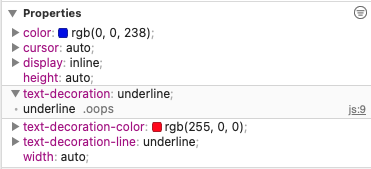What is the correct browser behaviour when you have CSS shorthands in combination with individual shorthand constituents?
Consider the following code.
a {
text-decoration-color: red;
}
.oops{
text-decoration: underline;
}
code {
border: 1px solid rgb(0 0 0 / 0.2);
padding-inline: 0.5em;
}<p>This <a href='#'>link</a> is underlined in red with <code>text-decoration-color: red</code>.</p>
<p>This <a href='#' class="oops">link</a> also has <code>text-decoration-color: red</code> applied, but is not underlined in red in Chrome or Firefox as it has <code>text-decoration: underline</code> applied, which is a short hand for <ul>
<li>text-decoration-color</li>
<li>text-decoration-line</li>
<li>text-decoration-style</li>
<li>text-decoration-thickness</li>
</ul></p>If you view this in Chrome or Firefox, the 2nd link is not underlined in red, as text-decoration-color is overridden by the text-decoration-shorthand (even though color is not specified as part of it). In Safari, it is underlined in red, as text-decoration-color overrides the shorthand.
The discrepancy can be easily resolved by changing text-decoration: underline to text-decoration-line: underline, but I am wondering... which is the correct behaviour here according to the spec?
It's as I suspected, but confirmed in the question comments ( by @TemaniAfif, and linked by @C3Roe)
Omitting properties: A value which is not specified is set to its initial value. That means that it overrides previously set values.
By using text-decoration (the shorthand), you're effectively setting each of the constituent properties to initial.
See the example below:
.secondand.thirdhave the same effect.fourthhas the desired effect (from your example) in that it doesn't override the previously set values
a {
text-decoration-color: red;
}
.second {
text-decoration: underline;
}
.third {
text-decoration-color: initial;
text-decoration-line: underline;
text-decoration-style: initial;
text-decoration-thickness: initial;
}
.fourth {
text-decoration-line: underline;
}<a href='#'>First</a>
</br>
<a href='#' class="second">Second</a>
</br>
<a href='#' class="third">Third</a>
</br>
<a href='#' class="fourth">Fourth</a>As for Safari...
From what I've seen in the Safari Elements panel, it appears that when using the shorthand for a property text-decoration, Safari will attempt to split that property into it's constituent properties.
- Why does an empty preprocessor command still evaluate to something?
- How to implement variable sized array within C struct
- Character array typecasting to integer
- How can I exclude non-numeric keys? CS50 Caesar Pset2
- How to get the sign, mantissa and exponent of a floating point number
- Why do MCU libraries use logic operations instead of bitfield structs?
- What kind of implementation can I use for a static associative array on a vintage system with very limited resources?
- Determine libraries to link against for a windows library function?
- Passing macro values to arm linker that places variable at a specific location
- running a program with wildcards as arguments
- How to perform addition of two vectors of 8-bit integers with a single addition in C/C++
- GNU RISC-V Embedded GCC throws "x ISA extension `xw' must be set with the versions" error
- Counting pulses using a swiss flow meter with an Arduino, how is it done?
- How to create a folder in C (need to run on both Linux and Windows)
- Is there any way to compute the width of an integer type at compile-time?
- How can I initialize all members of an array to the same value?
- Is C notably faster than C++
- How to get the Windows SDK version number a program is compiling with at compile time
- Confused by difference between expression inside if and expression outside if
- Equivalent of atoi for unsigned integers
- k&r: Exercise 1-18. Program takes input but doesnt produce any output?
- Using in C thrd_sleep() to either wait for time or interrupt by signal. Example?
- How can I compute `exp(x)/2` when `x` is large?
- c programming: answer always equates to 0
- Is it possible to access a parameter of a function from another function in C?
- Will this expression evaluate to true or false (1 or 0) in C?
- What Is the Return Value of strcspn() When Str1 Does not Contain Str2?
- Mapping a numeric range onto another
- Signalled and non-signalled state of event
- Why is faster to do a branch than a lookup?
